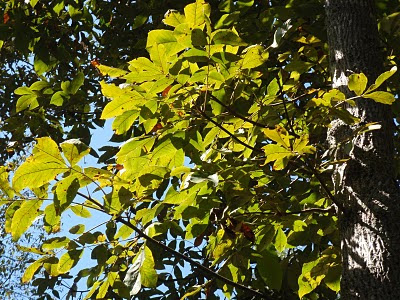100 Species Challenge--Hickory
HIckories abound around our house. Their leaves can turn the most spectacular yellow in the fall. It's still a little early for that here, though.

Hickories are deciduous, with edible nuts. I have cracked into a few and they taste a bit like walnuts. But it is haarrrd to crack into that shell and extract the meat intact (or at all, if you smash too hard). I have always wanted to try them in a recipe (the maple hickory apple crisp on this page sounds especially tantalizing) but I haven't yet figured out a way to get a sufficient amount of nut meat in a time-efficient manner. Perhaps next year I can enlist the help of the older ones. This year the squirrels and grubs have already got most of what's on the ground.

The tree grows very tall, accounting for a lot of our shade around here. It's an important hardwood--hickory is popular for furniture, tools, sports equipment, firewood, and curing meat. Based on some image comparisons of the leaves and bark among the different hickory species, I'd say this is a mockernut hickory (Carya tomentosa). We also have catkins all over the ground in the spring which look like the flowers described for the mockernut. This is a handy chart for identifying features of leaves, by the way. Using this (and confirming with Google), I determined that the leaves are ovate or obovate in shape, pinnately compound in arrangement. Looks like they are slightly serrated--finely toothed, I think I read. They're also pretty big, up to about 6-8 inches long.

1. Dogwood (Cornus florida)
2. mockernut hickory (Carya tomentosa)

Hickories are deciduous, with edible nuts. I have cracked into a few and they taste a bit like walnuts. But it is haarrrd to crack into that shell and extract the meat intact (or at all, if you smash too hard). I have always wanted to try them in a recipe (the maple hickory apple crisp on this page sounds especially tantalizing) but I haven't yet figured out a way to get a sufficient amount of nut meat in a time-efficient manner. Perhaps next year I can enlist the help of the older ones. This year the squirrels and grubs have already got most of what's on the ground.

The tree grows very tall, accounting for a lot of our shade around here. It's an important hardwood--hickory is popular for furniture, tools, sports equipment, firewood, and curing meat. Based on some image comparisons of the leaves and bark among the different hickory species, I'd say this is a mockernut hickory (Carya tomentosa). We also have catkins all over the ground in the spring which look like the flowers described for the mockernut. This is a handy chart for identifying features of leaves, by the way. Using this (and confirming with Google), I determined that the leaves are ovate or obovate in shape, pinnately compound in arrangement. Looks like they are slightly serrated--finely toothed, I think I read. They're also pretty big, up to about 6-8 inches long.

1. Dogwood (Cornus florida)
2. mockernut hickory (Carya tomentosa)

Comments